WARSAW PACT WEAPONS & EQUIPMENT 1970-1991

SKS 46 SIMONOV CARBINE

| Calibre: | 7.62x39mm | Muzzle Velocity: | 736m/s |
| Weight: | 3.85kg | Length: | 1.021m |
| Magazine Capacity: | 10 rounds | Rate of Fire: | 30 rounds/min |
| Effective Range: | 400m | Date in Service: | 1949 |
During World War II, the Soviet Union realised that existing rifles, such as the Mosin-Nagant, were too long, heavy
and fired powerful cartridges that created excessive recoil. It was noted that most firefights took place at maximum
ranges of between 100m and 300m. The Soviet Union tested a new intermediate round, 7.62x39mm in 1943, and a small number
of SKS rifles were tested on the front line in early 1945 against the Germans.
The SKS 46 Simonov is basically an improved version of Sergei Simonov AVS 36, but also incorporates some of the features
of the SVT-40 and M-44 Mosin-Nagant rifles that it replaced.
In 1949, the SKS was officially adopted into the Soviet Army, produced at the Tula Armoury from 1949 until 1955 and the
Izhevsk Armory in 1953 and 1954. Although the quality of Russian SKS rifles manufactured at these state-run arsenals was
quite high, it’s design was already obsolete compared to the Kalashnikov which was selective-fire, lighter, had three times
the magazine capacity, and also, had the potential to be less labor-intensive to manufacture.
AK-47 production increased until, by 1957, all front line troops were equipped with the new weapon, and SKS carbines were
issued to support arms, and the armed forces of other Warsaw Pact countries.
The SKS 46 Simonov remained in service in this fashion into the early 1990s, and to this day, the SKS carbine is used by
the ceremonial Russian Honour Guards.
Original Russian SKS rifles and copies can still be found today in the hands of third-world militias and insurgent groups.
During the Cold War, the Soviet Union shared the design and manufacturing details with its allies.
In total, 15,000,000 SKS rifles were manufactured by the Soviet Union, China, Yugoslavia, Albania, North Korea, Vietnam,
and East Germany (Kar. S) with limited pilot production (Model 56) in Romania and Poland (Wz49).
SKS carbines have also made appearances in recent conflicts in Africa, Afghanistan, and Iraq. Today the SKS is in service
with China, North Korea and Vietnam, as well as many other countries in Africa.
Nations that utilised the SKS but did not receive manufacturing rights included Afghanistan, Congo, Indonesia, Iraq, Laos,
Lebanon, Mongolia, Morocco, the United Arab Republic (Egypt), and the Yemen People's Democratic Republic.
AK 47 ASSAULT RIFLE

| Calibre: | 7.62x39mm | Muzzle Velocity: | 715m/s |
| Weight: | 4.3kg | Length: | 0.870m |
| Magazine Capacity: | 30 rounds | Rate of Fire: | 600 rounds/min |
| Effective Range: | 400m | Date in Service: | 1949 |
The AK-47 is a selective-fire, gas-operated 7.62x39mm assault rifle, first developed in the Soviet Union by Mikhail
Kalashnikov. The designation AK-47 stands for Kalashnikov Automatic Rifle, 1947 Model. It is officially known as Avtomat
Kalashnikova.
Design work on the AK-47 began in the last year of World War II (1945). In 1946, the AK-46 was presented for
official military trials, and in 1947 the fixed-stock version was introduced into service with select units of the Soviet
Army.
In 1949, the AK-47 was officially accepted by the Soviet Armed Forces and used by the majority of the Warsaw Pact countries.
The AK-47 was one of the first true assault rifles and its variants remain the most widely used and popular assault rifles
in the world because of its durability, low production cost, and ease of use. It has seen service with regular armed forces
as well as irregular, revolutionary and terrorist organizations worldwide. The AK-47 was the basis for developing many other
types of individual and crew-served firearms.
The AK family include:
AK-47 1948–51, 7.62x39mm.
AK-47 1952, 7.62x39mm.
AKS-47 Folding metal stock.
RPK, 7.62x39mm Hand-held machine gun version with longer barrel and bipod.
AKM, 7.62x39mm A simplified, lighter version of the AK-47.
AKMS, 7.62x39mm Folding-stock version of the AKM intended for airborne troops.
AK-74 series, 5.45x39mm
AK-101/AK-102 series
AK-103/AK-104 series
AK-107/AK-108 series
AK-200 series
75 million AK-47's have been produced, and over 100 million AK variant rifles have been produced, more than all other
assault rifles combined.
DRAGUNOV SVD SNIPER RIFLE

| Calibre: | 7.62x54mm | Muzzle Velocity: | 830m/s |
| Weight: | 4.3kg | Length: | 1.135m |
| Magazine Capacity: | 10 rounds | Rate of Fire: | 30 rounds/min |
| Effective Range: | 800m | Date in Service: | 1963 |
The SVD Dragunov sniper rifle is a semi-automatic sniper rifle chambered in 7.62x54mm, developed by the Soviet Union.
Three sniper rifles were tested, the SSV-58 designed by Sergei Simonov, the 2B-W10 designed by Alexander Konstantinov, and
the SVD-137, designed by Yevgeny Dragunov. After the trials the SVD-137 was chosen to be the standard Soviet Sniper rifle
and accepted into service in 1963. The initial pre-production batch consisted of 200 rifles, and from 1964 serial production
was carried out at the Izhevsk Mechanical Works.
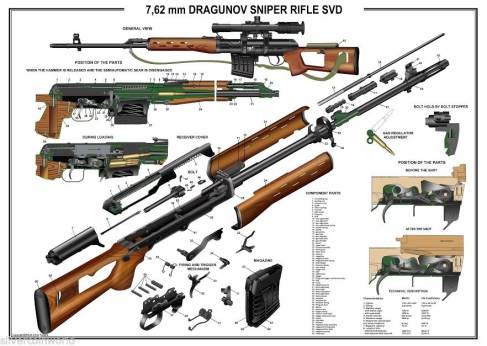
The Dragunov has become the standard sniper weapon of several countries, including those of the former
Warsaw Pact. Licensed production of the rifle was established in China (Type 79 and Type 85) and Iran (as a direct copy of
the Chinese Type 79).
The Dragunov has a two-piece wooden handguard and a skeleton type wooden "thumbhole" stock, fitted with removable cheek
rest. Newer production models have black, synthetic furniture similar to the earlier wood furniture, although the
thumbhole stock is of a different shape.
The Dragunov is issued with a quick-detachable PSO-1 optical sight. The PSO-1 sight has 4x magnification and 6° field of view,
mounted on a side rail, that does not block the view of the normal sight line.
Rifles designated SVDN come equipped with a night sight, such as the NSP-3, NSPU, PGN-1, NSPUM or the Polish passive PCS-6
and can be used to engage targets at 600m, at night.
SVD Variants:
In the early 1990s a compact variant of the SVD designed for airborne infantry was introduced, known as the SVDS, which
has a tubular metal folding stock, fitted with a synthetic shoulder pad and a fixed cheek riser, and a synthetic pistol grip.
It is fitted with a heavier barrel, the receiver housing was strengthened, the gas cylinder block was improved and a ported,
and a conical flash hider was adopted.
The SVD Dragunov was not meant for highly trained sniper teams, but instead, for designated marksmen. In every platoon of
Warsaw Pact troops, there was a Dragunov marksman.
DEGTYARYOV LIGHT MACHINE GUN (RPD)
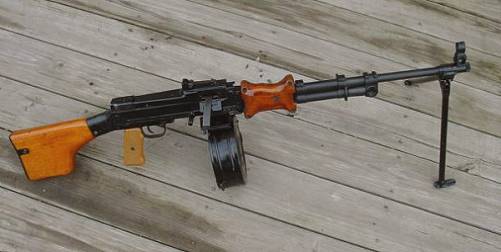
| Calibre: | 7.62x39mm | Muzzle Velocity: | 735m/s |
| Weight: | 7.43kg | Length: | 1.037m |
| Magazine Capacity: | 100 round belt | Rate of Fire: | 650 rounds/min |
| Effective Range: | 550m | Date in Service: | 1953 |
The RPD Ruchnoy Pulemyot Degtyaryova, is a 7.62mm light machine gun developed in the Soviet Union by Vasily Degtyaryov
for the intermediate 7.62x39mm M43 cartridge. It was created as a replacement for the DP machine gun chambered for the
7.62×54mmR Mosin rifle round.
Work on the weapon commenced in 1943. Three prominent Soviet engineers were asked to submit their own designs: Vasily
Degtyaryov, Sergei Simonov and Alexei Sudayev. Among the completed prototypes prepared for evaluation, the Degtyaryov
design proved superior and was accepted into service with the Soviet armed forces as the RPD, Ruchnoy Pulemyot Degtyaryova
or "Degtyaryov light machine gun") model 1944. Although the RPD was ready for mass production during the final stages of
World War II, large scale delivery of the weapon did not begin until 1953 during the Vietnam War, the RPD served the
Vietcong as their standard general-purpose machine gun.
After the introduction of the Kalashnikov-pattern support weapons such as the RPK and PK machine guns in the 1960s,
the RPD was withdrawn from most first-tier units of the former Warsaw Pact. However, the RPD remains in active service
in many African and Asian nations. Apart from the former Soviet Union, the weapon was manufactured in China (as the Type
56 LMG), Egypt, North Korea (Type 62) and since 1956—Poland.
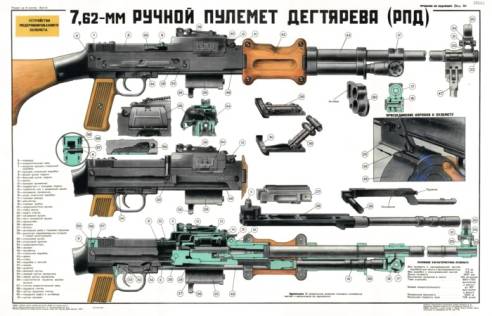
The RPD is an automatic weapon using a gas-operated long stroke piston system and a locking system recycled from previous
Degtyaryov small arms, consisting of a pair of hinged flaps set in recesses on each side of the receiver. The movement of
these flaps and the resulting locking and unlocking action is controlled by carefully angled surfaces on the bolt carrier
assembly. The weapon fires from an open bolt.
The machine gun feeds from the left-hand side from a segmented, open-link metallic belt (each segment holds 50-rounds).
Two combined belts (linked by cartridge), containing a sum total of 100 rounds are stored in a metal container resembling
a drum, attached to the base of the receiver or can simply be fed by a loose belt without a drum magazine with a longer
desired length rather than only 100 rounds if need be. The feed system is operated by a roller connected to the
reciprocating bolt carrier assembly and the belt is pulled during the rearward motion of the bolt carrier. Noteworthy
is that the drum magazine's design flaw is the fact that it is unreliable in dirty conditions and can become clogged
with filth and other natural elements if they enter the magazine.
During its service life, the weapon was modernised several times. Initially, the gas block was modified as was the rear
sight, where the windage adjustment knob for the rear sight was moved to the left side of the notch. Later, the RPD was
modified with a non-reciprocating cocking mechanism with a folding charging handle (replacing the fixed charging handle
connected to the bolt carrier) that does not move during firing. The feed port received a dust cover, which when open,
serves as a feeding ramp for the ammunition belt. This version of the light machine gun was produced mainly in China and
Poland. A further modified variant (sometimes referred to as the RPDM) includes an extended gas cylinder and a recoil
buffer mechanism in the stock. Late production RPD variants also had the fixed drum attachment removed (instead, the
ammunition container was “hung” from the feed port cover) and feature a folding cleaning rod, that is stored in the
weapon’s butt (in the Chinese Type 56-1 variant).
KALASHNIKOVA GENERAL PURPOSE MACHINE GUN (PKM)
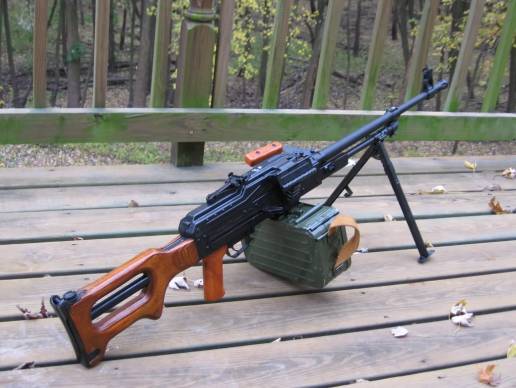
| Calibre: | 7.62x54mmR | Muzzle Velocity: | 825m/s |
| Weight: | 9.00kg | Length: | 1.192m |
| Magazine Capacity: | 200 round belt | Rate of Fire: | 650 rounds/min |
| Effective Range: | 1,000m | Date in Service: | 1961 - PRESENT |
The PK (Russian: Pulemyot Kalashnikova, or "Kalashnikov's Machinegun"), is a
7.62mm general-purpose machine gun designed in the Soviet Union and currently in production in Russia. The original
PK machine gun was introduced in 1961 and then the improved PKM in 1969 to replace the SGM and RP-46 machine guns in
Soviet service. It remains in use as a front-line infantry and vehicle-mounted weapon with Russia's armed forces.
The PK has been exported extensively and produced in several other countries under license.
The Main Artillery Directorate of the Soviet Union adopted specification requirements for a 7.62mm general-purpose
company, and battalion-level machine gun, chambered for a rifle cartridge in 1955. In 1958 a machine gun prototype,
developed by G.I. Nikitin and Yuri M. Sokolov, successfully passed field tests. Based on the results of the tests
it was decided in 1960 to manufacture a batch of Nikitin-Sokolov machine guns for service tests and then put the
machine gun into production at the Kovrov Mechanical Plant. When the Nikitin-Sokolov machine gun was almost completed,
a team of Izhevsk Mechanical Plant designers, headed by M.T. Kalashnikov, and further consisting of M.T. Kalashnikov,
V.V. Krupin, V.N. Pushchin, A.D. Kryakushin, as well as Startsev, Kamzolov, Koryakovtsev, Yuferev, joined the competition.
Their machine gun prototype was based on the well-proven gas-operated rotary-bolt design of the Kalashnikov-pattern arms.
The Kalashnikov and the Nikitin-Sokolov prototypes underwent service tests in the Central Asia, the Odessa, and the Baltic
military districts, as well as at the Vystrel officer training courses in late 1960. The Main Missiles and Artillery Directorate
and the Ministry of the Defence Industry preferred the Kalashnikov design. The Kalashnikov design was found to be more reliable
and cheaper to manufacture than the design of Grigory Nikitin and Yuri Sokolov. The PK/PKS was put into production at the
Kovrov Mechanical Plant and used the tripod mount and an ammunition belt boxes originally designed for the Nikitin-Sokolov
prototype machine gun.Nikitin's and Sokolov's machine gun design was later used in the 12.7 mm NSV heavy machine gun that was put into production in 1971.
The bolt and carrier design are similar to the AK-47 and other modernised Kalashnikov-pattern weapons, as is the stripping procedure
performed to remove those mechanisms from the gun for cleaning. The bolt and bolt carrier are however oriented upside down compared
to the AKM, with the piston and gas system being underneath the barrel.
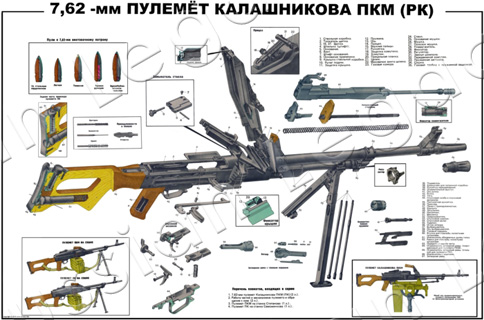
Unlike the AKM and RPK the PK machine gun series is an open bolt design, which improves heat management during automatic fire
compared to closed bolt designs and helps avoiding the dangerous phenomenon known as "cook-off", wherein the firing chamber
becomes so hot that the propellant contained in a chambered round unintentionally ignites, making the weapon fire until the
ammunition is exhausted. Open bolt designs typically operate much cooler than closed bolt designs due to the airflow allowed
into the chamber, action and barrel during pauses between bursts, making them more suitable for constant full-automatic weapons
such as machine guns. General-purpose machine guns like the PK are further normally issued with several quick change barrels that
during prolonged intensive use are swapped out allowing one barrel to cool while the machine gun fires with the other.
The rimmed 7.62×54mmR cartridges are set in a metal ammunition belt, and are held against the shoulder inside non disintegrating
looped links, leaving the rim exposed at the rear. The belt is mounted from the right side into the feedway of the PK machine gun.
The PK uses a non-reciprocating charging handle on the right side of the receiver to charge the gun. Since the PK uses a rimmed rifle
cartridge and closed-link belts used for feeding, a two-stage feed mechanism with a preliminary extraction of a cartridge from a belt
link was preferred over a direct ammunition feed design often used for rimmed cartridges. The PK machine gun is equipped with a lever-type
feed mechanism, mounted on the feed cover and operated by the feed lever, mounted on the right wall of the receiver and wrapping around the
bolt carrier with its feed pawl and roller. The PK feed mechanism pulls the rimmed 7.62×54mmR cartridges out from the back of the ammunition
belt and drops the cartridges down into the feed way, allowing the bolt to strip and feed the cartridges into the chamber for firing.
The breech is locked by a rotating bolt, with two locking lugs engaging locking recesses in the receiver. The gas piston is hinged to the bolt carrier
assembly, and its vertical travel makes it possible to bend the group making machine gun assembly and disassembly for maintenance easier.
The protruding rear part of the bolt carrier assembly features spiral shaped cuts, which provide a controlled rotation of the bolt. The mainspring
is accommodated in the bolt carrier assembly slide channel. A cartridge extractor with a latch is mounted in the rear part of the bolt carrier assembly.
The cocking lever, mounted on the right, is not integral with the bolt carrier and does not reciprocate as the gun fires. The machine gun fires
from the rear sear.
The gas cylinder is mounted under the barrel and fitted with a gas regulator with three fixed positions. The gas regulator opens
corresponding holes to change the amount of expanding propellant gases bled off out of the gas cylinder into the atmosphere, thus
varying the amount of energy transferred on to the long-stroke piston.
The PK general-purpose machine gun U-shaped receiver is stamped from a smooth 1.5 mm (0.06 in) sheet of steel that is supported extensively
by pins and rivets. For additional rigidity and strength the PK receiver features double walls made from 1.5 mm steel plates that are welded
together with the U-shaped stamping. The receiver top cover is also stamped from 1.5 mm sheet metal and hinged on the front of the receiver
and locked at the back with a spring-loaded latch.
The quick detachable barrel assembly slides into to the receiver and attaches by a barrel-lock. On the original PK it was partially fluted to
increase rigidity and improve heat dissipation. The barrel-lock also regulates the gap between the breech face and the breech end of the barrel.
PK barrels have a folding carry handle/grip that is positioned to the left of the receiver and is used to transport the weapon and quickly and
safely change-out barrels to prevent barrel overheating. The bore is chrome-lined and features 4 right-hand grooves at a 240 mm (1 in 9.45 in)
rifling twist rate. The muzzle is threaded for the installation of various muzzle devices such as a flash hider. The muzzle was normally equipped
with a conical flash suppressor that added 53 mm (2.1 in) to the barrel and later a long slotted flash suppressor that added 72 mm (2.8 in) to the
barrel. Later when the PKM variant was introduced the PK series barrel fluting was omitted and the muzzle device was changed to a shorter
cylindrical slotted flash suppressor that added 40 mm (1.6 in) to the barrel.
ROCKET PROPELLED GRENADE (RPG)
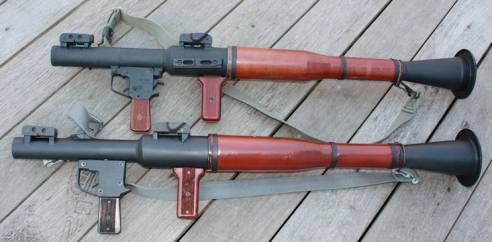
| Calibre: | 40mm | Muzzle Velocity: | 150m/s |
| Weight: | 6.3kg | Length: | 0.950m |
| Magazine Capacity: | N/A | Rate of Fire: | N/A |
| Effective Range: | 700m | Date in Service: | 1961 - PRESENT |
The RPG-7 (Russian: Ruchnoy Protivotankovyy Granatomyot) is a portable, un-guided, shoulder-launched, anti-tank rocket-propelled grenade launcher.
Originally the RPG-7 and its predecessor, the RPG-2, was designed by the Soviet Union; it is now manufactured by the Russian company Bazalt.
The weapon has the GRAU index 6G3. The English-language term "rocket-propelled grenade", though frequently encountered and reasonably descriptive,
is a backronym for "RPG" and not based on a literal translation.
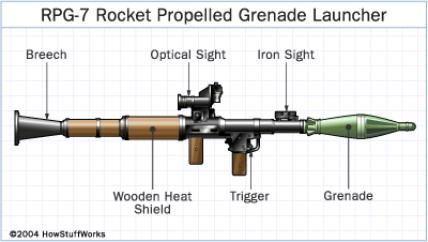
The ruggedness, simplicity, low cost, and effectiveness of the RPG-7 has made it the most widely used anti-armour weapon in the world. Currently
around 40 countries use the weapon, and it is manufactured in a number of variants by nine countries. It is also popular with irregular and guerrilla
forces, such as the Provisional IRA. The RPG has been used in almost all conflicts across all continents since the mid-1960’s from the Vietnam War
to the early 2010’s War in Afghanistan.
Widely-produced, the most commonly seen major variations are the RPG-7D paratrooper model (able to be broken into two parts for easier carrying),
and the lighter Chinese Type 69 RPG. DIO of Iran, manufactures RPG-7s with olive green handguards, H&K pistol grips, and a Commando variant.
The RPG-7 was first delivered to the Soviet Army in 1961 and deployed at a squad level. It replaced the RPG-2, having clearly out-performed the
intermediate RPG-4 design during testing. The current model produced by Russian Federation is the RPG-7V2, capable of firing standard and dual
high explosive anti-tank (HEAT) rounds, high explosive/fragmentation, and thermobaric warheads, with a UP-7V sighting device fitted (used in tandem
with the standard 2.7× PGO-7 optical sight) to allow the use of extended range ammunition. The RPG-7D3 is the equivalent paratrooper model. Both
the RPG-7V2 and RPG-7D3 were adopted by the Russian Ground Forces in 2001.